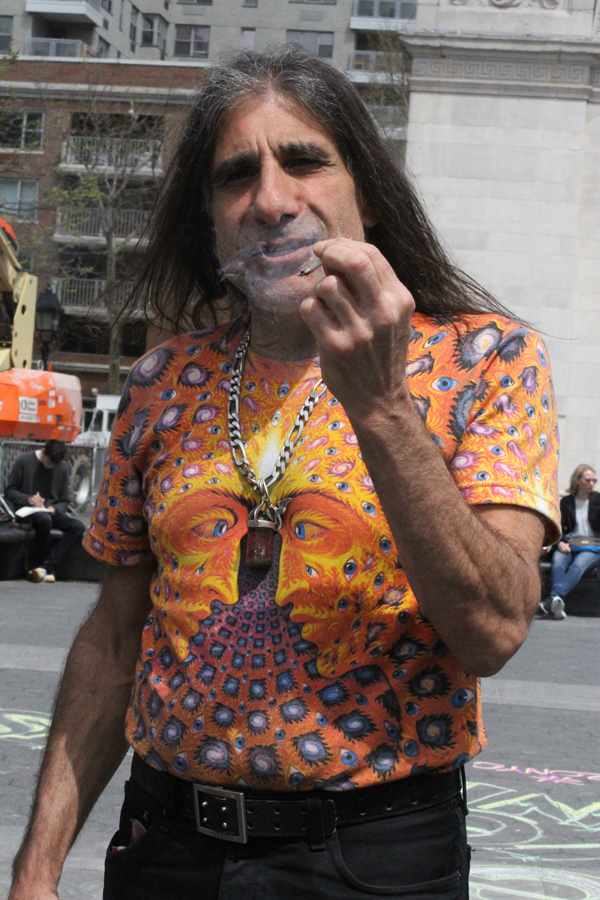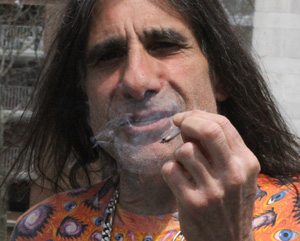BY PAUL DeRIENZO | Marijuana was on the agenda and in the air on April 21, celebrating a day late because of a heavy downpour on the assigned date of 420, which is the unofficial sacred day of pot smokers everywhere.
The exact reason behind 420’s status with potheads is lost in the smoky haze of the past. But an ongoing debate in the pages of the nation’s preeminent pot monthly High Times cites the birth of the custom of lighting up a joint at exactly 4:20 p.m. each afternoon with a group of 1970s high school students who would toke up to celebrate the end of each school day before a practice session of their garage rock band.
The bright, sunny Tuesday in Washington Square Park seemed a perfect backdrop for the mix of young activists and gray-haired hippies to sneak a toke as Park Enforcement Patrol officers and, later, police scanned the edges of the small crowd, warning that smoking — anything — is prohibited in city parks.
Still, the acrid whiff of burning weed did waft through as organizer Jano Tantongco, self-styled leader of the Cannabis Legalization Coalition, spoke over a small sound system. He began by critiquing Mayor Bill de Blasio’s reform policy under which police are now ticketing instead of arresting people found in possession of small amounts of marijuana. Tantongco said the mayor’s move, while laudable, was not enough, and he demanded, to the applause of about 100 supporters and passersby, that New York follow the lead of the four Western states that have legalized pot for recreational use.
New York has for nearly half a century hosted its own marijuana celebration on the first Saturday in May, which has usually consisted of a parade of happy smokers culminating in a rally and concert.
In its earliest incarnations the rally went up Fifth Ave. and the concert was held in at the Central Park band shell. But after a series of battles over sound levels and permits with the city that went to the U.S. Supreme Court in the 1980s, the pot parade was left looking for a new home.

During the decidedly un-pot-friendly administration of Rudy Giuliani, police swept in on the event at Washington Square Park, arresting hundreds and basically driving the movement underground, until the election of the first admitted pot-smoking mayor, Michael Bloomberg, signaled improved relations with the police.
Under Bloomberg, though, police ratcheted up their “broken windows” policy of arresting mostly African American youth for small infractions, often finding marijuana in the process, and driving pot arrests to more than 50,000 a year.
Mayor de Blasio, despite easing pot laws, has strongly supported continuing the policy of zero tolerance for small offenses, which Police Commissioner William Bratton believes has been central to New York’s relative reduction in crime over the past 20 years.
At a press conference in front of the Manhattan District Attorney’s office last week, another group of pot activists with a different agenda harkening back to the bad old days of high crime New York City, met to demand that D.A. Cy Vance, Jr. promise not to target medical marijuana “dispensaries.”
The group wants legal pot shops, now that the state has approved a restrictive law allowing for the medicinal use of grass. Dana Beal — a New York activist fresh out of jail after doing three years in Wisconsin and Nebraska after being caught with several hundred pounds of weed he says was earmarked for New York City medical marijuana patients — was there along a handful of supporters, including subway vigilante Bernhard Goetz.
Goetz rose to infamy when in December 1984 when he shot four young African American men on a subway who he claimed had threatened him. All four were seriously wounded. At the time, Goetz justified the shooting as self-defense by saying that New York City was “lawless.” But earlier this month at the D.A.’s office, he said it was time to legalize possession of “less than 25 grams” of pot. In 2013 Goetz, a vegetarian who rescues injured squirrels in city parks, was arrested for allegedly taking $30 from an undercover cop in exchange for some pot outside Union Square Park. The charges were later dropped. Beal said the D.A. was unfairly targeting Goetz because the city had failed to convict him on more than gun-possession charges after the subway shooting 30 years ago.
Meanwhile, Beal, who used to live in a three-story walk-up he rented for 40 years at 9 Bleecker St., implied he’d like to regain possession of at least part of the building to open the city’s first legal medical marijuana dispensary. He added that he wants Vance to agree in writing not to prosecute pot patients who would use the facility. In an e-mail, Vance’s office told Beal they would not meet with him to discuss the demands. Beal is undeterred and plans to continue his campaign for medical pot in New York City.
Under Governor Cuomo, the state has approved limited — and non-smokable — medical marijuana. For now, plans are only to allow up to 20 dispensaries to open throughout the entire state.
The pot parade this year will kick off on Sat., May 2, with an assembly beginning at 11 a.m. on Broadway between 31st and 32nd Sts., then marching down Broadway to Union Square, where a rally from 1 p.m. until 5 p.m. will feature performances, music and speeches by pot advocates.


















